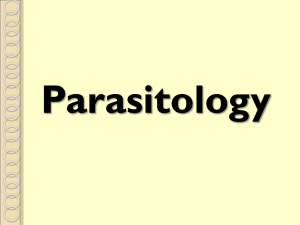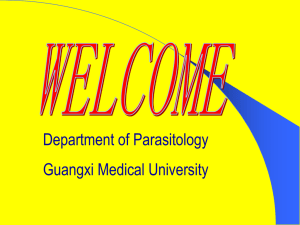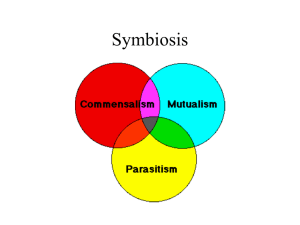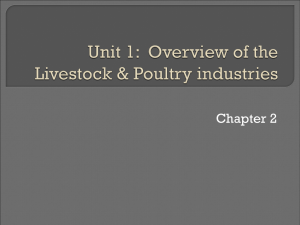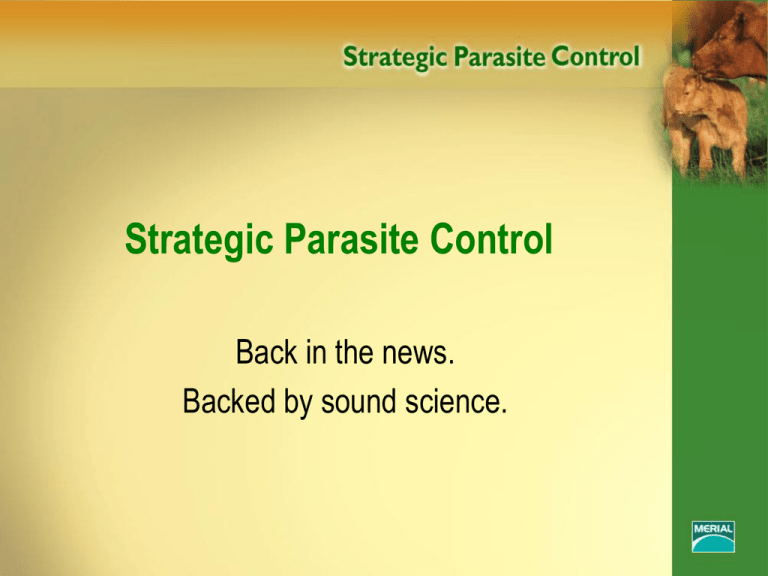
Strategic Parasite Control
Back in the news.
Backed by sound science.
Strategic Parasite Control –
The Buzz Today
March 2005 Drovers
“Deworming calves (beginning in the spring) may be the most
cost-effective management practice around: it results in
healthier calves with healthier immune systems, weight gains
that provide return on investment and cleaner pastures.”
March 2005 JAVMA
A series of 11 South Dakota trials demonstrates the value of
controlling internal parasites at spring turnout and throughout
the grazing season.
The Concept Has Always
Been Appealing
“It would seem that a new approach is being made in the control of
nematode parasites. The emphasis is now on pasture hygiene,
achieved by combining the intelligent use of anthelmintics with
controlled grazing in such a way as to protect young animals
from heavy infestations and at the same time to build up their
resistance to parasitic diseases. The same principles may be
applied to practically all helminth infections and as better
anthelmintics become available and more knowledge of life
cycles and bionomics of various parasites are acquired, there is
every reason to hope that the tremendous losses due to
parasitism of farm livestock will be greatly reduced.”
– A. Russell, 1949 Vet Rec 61:238-239.
The Science Has Always
Been Sound
Preventive approach
Multiple treatments
Reduce parasite populations below
performance threshold
Reduce pasture contamination
The Benefits Have Always
Been Compelling
Increased weight gains
Heavier weaning weights
Improved immune response to vaccinations
Reduced pasture contamination
Parasite Signs –
Rarely Seen
– Dr. Bert Stromberg, University of Minnesota
Clinical Parasitism
Diarrhea
Bottle jaw
Anemia
Rough hair coat
Subclinical Parasitism
Reduced weaning weight
Reduced milk production
Reduced reproductive performance
Reduced growth rate
Increased susceptibility to disease
Negative effects on immune response
Parasite Populations –
Rarely in the Host
5% in host
95% in pasture
– Dr. Bert Stromberg, University of Minnesota
“The primary purpose of parasite control is not to
cure sick animals…but to reduce levels of
pasture contamination and consequently prevent
such episodes of illness or reduced productivity.”
SOURCE: Williams JC, Loyacano AF. Internal Parasites of Cattle in Louisiana and Other Southern States. LSU
Research Information Sheet #104 (2001):13.
Strong Demand and Markets Make
SPC Hard to Ignore
High demand and high prices raise the stakes
Every pound of production is worth more
It gets harder for all producers to ignore the
value of SPC
Why Isn’t Everybody Using
Strategic Parasite Control?
Why Isn’t Everybody Using
Strategic Parasite Control?
Tradition
(“Dad only wormed cattle once a year.”)
Why Isn’t Everybody Using
Strategic Parasite Control?
Tradition
Lack of understanding of epidemiology
(“What difference does it make when I treat cattle?”)
Why Isn’t Everybody Using
Strategic Parasite Control?
Tradition
Lack of understanding of epidemiology
Lack of convenience
(“I’ll just wait and treat them for parasites when
I’ve got a good reason to handle them.”)
Economic Impact of Cattle Parasites
GI Nematodes
0.4 to 1.0 lb per day
10:1 ROI
Horn Flies
0.2 lb per day
5:1 ROI
*Derouen SM, Foil LD, Knox JW, Turpin JM, Horn Fly Control and Weight Gains of Yearling Beef Cattle, 1995 Veterinary Entomology
*
Why Isn’t Everybody Using
Strategic Parasite Control?
Tradition
Lack of understanding of epidemiology
Lack of convenience
Subclinical infections are often overlooked
Effectiveness of today’s endectocides
(“We killed a whole bunch of parasites a few
weeks ago. That should hold ’em.”)
Merial Hosts
Parasitologist Symposium
Leading cattle parasitologists attending
To review established benefits of Strategic
Parasite Control
To identify regional differences in parasite control
To discuss the latest in Strategic Parasite Control
Treat the Cattle.
Clean up
the Pasture.
Where are the Parasites?
5% to 10%
In Host
90% to 95%
On Pasture
- Dr. Bert Stromberg, University of Minnesota
Seasonal Transmission Patterns
(Cool- vs. Warm-Season Parasites)
(for graphical representation only)
Relative transmission of nematodes and lungworms
in cattle in the southeastern United States.
- Dr. Thomas Craig, Texas A&M
Season Transmission Patterns – Northern US
(Total Worms and Inhibited L4 Larvae)
(for graphical representation only)
Eggs per gram
epg's
Dynamics of
Parasite Transmission – Northern US
180
160
140
120
100
80
60
40
20
0
May
Cow
Calf
Jun
Jul
Aug
Month
- Dr. Bert Stromberg, University of Minnesota
Sep
Oct
Mathematics of Parasite Infection
Conservative parasite load 2 eggs/gram
Average fecal production
20 kg/day
Daily production/animal
40,000 eggs
For a 100-cow herd:
4,000,000 eggs/day
Cattle are Hosts – and Multipliers
6
Total
x 10
year (millions)
per eggs
Eggs
35
30
25
20
Calf
Cow
15
10
5
0
May
Jun
Jul
Aug
Month on pasture
- Dr. Bert Stromberg, University of Minnesota
Sep
Oct
Pasture Contamination –
A Vicious Cycle - Southern US
(for graphical representation only)
Data on file at Merial.
Does Winter Kill Off Parasites?
Infected larvae on pasture survive winter to reinfect
cattle in spring
Cold and dry: reduced survivability
Cold and snow: survivability is high
Research shows that parasites can also be transmitted
during cold Northern winters
–Dr. Bert Stromberg, University of Minnesota
Why Spring Treatment is Important
Spring pastures will be contaminated with
overwintered parasites
Rapid growth of cool-season pasture grasses
encourages grazing
Spring-treated cows wean heavier calves
Spring vaccinations are more effective when cattle
are parasite-free
Change in Mass of Draining Lymph
Nodes After Infection with Ostertagia
28 days after infection,
the immune system is
negatively affected by the
presence of parasites*
*Data on file at Merial.
Timing is Everything
March 2005 Drovers
“Deworming calves (beginning in the spring) may be the most cost-effective
management practice around: it results in healthier calves with healthier
immune systems, weight gains that provide return on investment and
cleaner pastures.”
0-wk + 10-wk program
32.66 lbs
3-wk + 10-wk program
43.56 lbs
March 2005 JAVMA
Cattle receiving consistent control throughout the grazing season (using the
IVOMEC® SR Bolus) had higher average daily gains.
A series of 11 South Dakota trials demonstrates the value of controlling
internal parasites at spring turnout and throughout the grazing season.
The Importance of Multiple
(Effective) Treatments
Trial comparing multiple treatments
IVOMEC® 8x program
IVOMEC 3x program
Fenbendazole 3x program
Control group (w/salvage
treatments of IVOMEC)
SOURCE: Williams JC, et al. Agri-Practice 1992
373 lbs
282 lbs
189 lbs
259 lbs
In a Perfect World…
You could provide consistent control throughout
the grazing season with a single treatment
The real-world alternative is to maintain low
parasite populations with multiple, well-timed
treatments
Sustained Release = Optimal Gains
Effect of IVOMEC® SR Bolus on weight gains.*
Mean Weight Gain – Increase (P<0.01)
120
+111
100
+92
80
+75
+67
60
40
+41
20
0
Tennessee
Arkansas
Mississippi
*Jacobsen JA, et al. Productivity of cattle treated with the IVOMEC® SR Bolus,
Proceedings of the American Assoc. of Veterinary Parasitologists, #75, July, 1996.
Florida
Missouri
IVOMEC® SR Bolus
vs. Popular Endectocides
Demonstration Trials*
70
IVOMEC Pour-On
60
IVOMEC Plus
Weight Gains
50
VALBAZEN®
40
IVOMEC 1% Injection
30
20
10
0
TX
TX
AR
AR
LA
LA
IVOMEC®
LA
*Jacobsen JA, et al. Productivity of cattle treated with the
SR Bolus,
Proceedings of the American Assoc. of Veterinary Parasitologists, #75, July, 1996.
MS
MS
MS
Maximum Cow/Calf Parasite Control
If the goal is to achieve maximum parasite control with minimal
pasture contamination and reinfection, multiple treatments will
be necessary
With endectocides, reinfection via eggs will resume in
approximately five weeks
Re-treatment every five weeks will control the worms in the
animal and continue to reduce pasture contamination (Williams
et al Agri-Practice 1992 had eight treatments)
Note: Trial conducted on stockers.
Optimum Cow/Calf Parasite Control
Spring treatment with an endectocide when spring grazing begins
Treat again five weeks later with an endectocide
Treat again eight weeks later with an endectocide
Treat again eight weeks later with an endectocide
Treat again eight weeks later with an endectocide
This treatment schedule will result in ultimate parasite
control and maximum productivity benefits
(Williams et al Agri-Practice 1992 had eight treatments)
Note: Trial conducted on stockers.
In Your World…
Regardless of timing/schedule and parasite problems
(including flukes, coccidia, Ostertagia and other internal
and external parasites) IVOMEC® Brand products can
combine for an effective SPC program.
Strategic Parasite Control –
It Makes More Sense Than Ever
Spring treatment helps
Reduce pasture contamination
Deliver heavier weaning weights
Better vaccination response
Multiple treatments maintain low parasite
levels – in cattle and in the pasture
Strategic Parasite Control pays off
Northern Cow/Calf Recommendations
Treatment 1 – Spring (April or May)
Treat cows and calves over 200 pounds (2 months)
with IVOMEC® EPRINEX® or IVOMEC Plus
Treatment 2 – Summer (July)
Treat calves or cows and calves with EPRINEX
Treatment 3 – Fall (October or at weaning)
Treat cows with IVOMEC Pour-On, EPRINEX or IVOMEC Plus
Note: Weaned calves that are retained (stockers, replacement heifers, young bulls) will also need to be treated in the fall.
See Slide #40.
Southern Cow/Calf Recommendations
Treatment 1 – Spring (February through May)
Treat cows and calves over 200 pounds (2 months)
with IVOMEC® EPRINEX® or IVOMEC Plus
Treatment 2 – Mid-Summer (July)
Treat cows and calves with EPRINEX
Treatment 3 – Fall (September, October, November)
Treat cows and weaned animals with IVOMEC Plus
or EPRINEX*
*Weaned calves that are retained (stockers, replacement heifers, young bulls) will need additional treatments.
See Slide #41.
Northern Plains & South
Weanling Recommendations
(Stockers, Replacement Heifers, Young Bulls)
Treatment 1 – Weaning or upon receiving –
Treat with IVOMEC® Plus
Treatment 2 – Treat again six to eight weeks later
(Days 45 to 60) – treat with IVOMEC EPRINEX® or
IVOMEC Plus
Treatment 3 – Treat again three months later with EPRINEX
or IVOMEC Plus (Day 150), just before breeding season
Treatment 4 – Treat again three months later with EPRINEX
or IVOMEC Plus (Day 240), just after breeding season for
replacement heifers
Note: Some herds may need additional treatments for maximum profitability.
Western Cow/Calf Recommendations
(Coastal & Foothills – San Francisco Bay)
Treatment 1 – Spring (April or May)
Treat cows and calves over 200 pounds (2 months) with
IVOMEC® Plus prior to movement to spring pasture
Treatment 2 – Fall (November) or weaning –
Treat cows and fall calves with IVOMEC Plus
Treatment 3 – Winter (January or February) –
Treat cows and fall calves with IVOMEC Plus
Western Cow/Calf Recommendations
(Central Valley and Mountains)
Treatment 1 – Spring (March, April, May) –
Treat cows and calves over 200 pounds (2 months) with
IVOMEC® Plus
Treatment 2 – Summer (July) or weaning –
Treat cows and calves with IVOMEC EPRINEX®
Treatment 3 – Fall/weaning (September to November) –
Treat cows and weaned calves with IVOMEC Plus or
IVOMEC Pour-On
NOTE: Weaned calves that are retained (stockers, replacement heifers, young bulls) will need additional treatments.
See Slide #44.
Western Weanling Recommendations
(Stocker cattle, replacement heifers, young bulls)
Treatment 1 – Weaning or upon receiving –
Treat all cattle with IVOMEC® Plus
Treatment 2 – Treat again in six to eight weeks with
IVOMEC Plus
Treatment 3 –Treat again with IVOMEC Plus when moved to
spring pasture (fall weaned animals) or at the end of summer
grazing (spring weaned animals)
NOTE: Some herds may need additional treatments for maximum profitability.
How Much Weight Gain
Do You Need to
Pay for One of These
Control Programs?
Cost Comparison of Parasite Control
Selling price of cattle
Cost
Cost
Cost
Cost
of
of
of
of
current parasite product
labor per head
shrink per head
shrink per head
Days of activity
$90.00 per 100 lbs.
$0.50
$1.00
$0.00
$1.50
30 days
Cost per day of activity
$0.05000
Additional pounds needed
Additional pounds needed per day
1.67
0.05556
Cost
Cost
Cost
Cost
of
of
of
of
IVOMEC Plus parasite control
labor per head
shrink per head
shrink per head
Days of activity
lbs.
lbs.
$1.58
$1.00
$0.00
$2.58
30 days
Cost per day of activity
$0.08600
Additional pounds needed
Additional pounds needed per day
2.87
0.09556
lbs.
lbs.
Difference in treatments (total)
Difference per day (lbs.)
1.20
0.04000
lbs.
lbs.
MERIAL® Brand Products for
Strategic Parasite Control
IVOMEC Plus (ivermectin/clorsulon)
IVOMEC (ivermectin) Pour-On
IVOMEC 1% Injection
IVOMEC EPRINEX
CORID
®
®
(amprolium)
®
(eprinomectin)
Pour-On
®MERIAL, CORID, EPRINEX and IVOMEC are registered trademarks of Merial.
All other brands in capital letters are registered trademarks of their respective holders.
©2005 Merial Limited. Duluth, GA. All rights reserved. (7/05)




